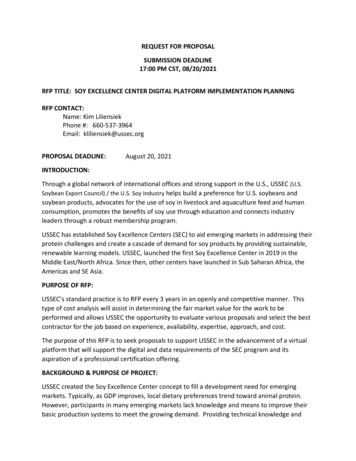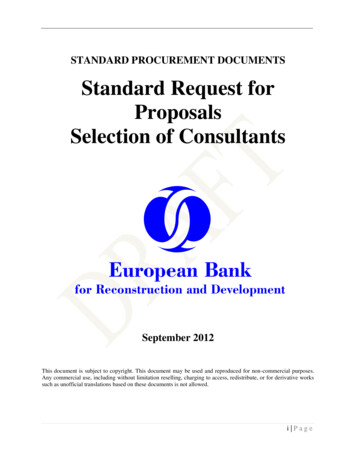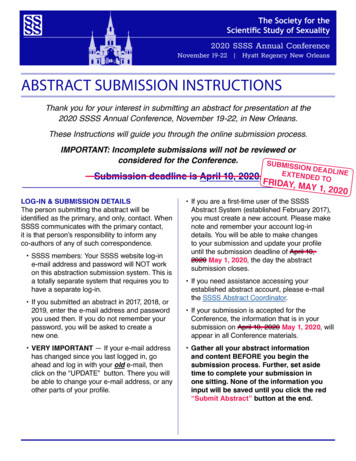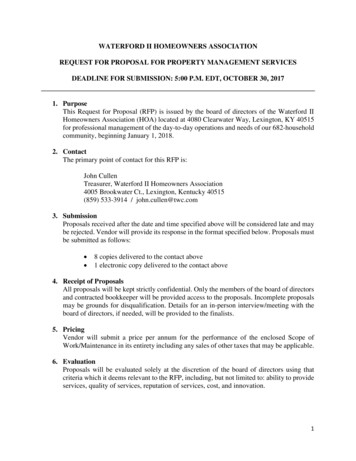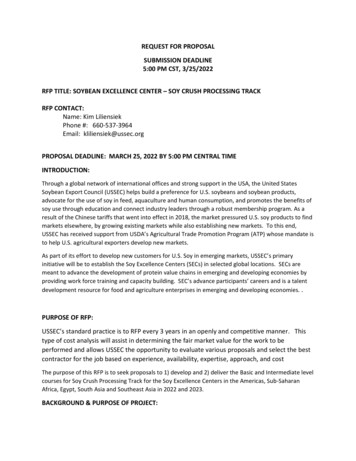
Transcription
REQUEST FOR PROPOSALSUBMISSION DEADLINE5:00 PM CST, 3/25/2022RFP TITLE: SOYBEAN EXCELLENCE CENTER – SOY CRUSH PROCESSING TRACKRFP CONTACT:Name: Kim LiliensiekPhone #: 660-537-3964Email: kliliensiek@ussec.orgPROPOSAL DEADLINE: MARCH 25, 2022 BY 5:00 PM CENTRAL TIMEINTRODUCTION:Through a global network of international offices and strong support in the USA, the United StatesSoybean Export Council (USSEC) helps build a preference for U.S. soybeans and soybean products,advocate for the use of soy in feed, aquaculture and human consumption, and promotes the benefits ofsoy use through education and connect industry leaders through a robust membership program. As aresult of the Chinese tariffs that went into effect in 2018, the market pressured U.S. soy products to findmarkets elsewhere, by growing existing markets while also establishing new markets. To this end,USSEC has received support from USDA’s Agricultural Trade Promotion Program (ATP) whose mandate isto help U.S. agricultural exporters develop new markets.As part of its effort to develop new customers for U.S. Soy in emerging markets, USSEC’s primaryinitiative will be to establish the Soy Excellence Centers (SECs) in selected global locations. SECs aremeant to advance the development of protein value chains in emerging and developing economies byproviding work force training and capacity building. SEC’s advance participants’ careers and is a talentdevelopment resource for food and agriculture enterprises in emerging and developing economies. .PURPOSE OF RFP:USSEC’s standard practice is to RFP every 3 years in an openly and competitive manner. Thistype of cost analysis will assist in determining the fair market value for the work to beperformed and allows USSEC the opportunity to evaluate various proposals and select the bestcontractor for the job based on experience, availability, expertise, approach, and costThe purpose of this RFP is to seek proposals to 1) develop and 2) deliver the Basic and Intermediate levelcourses for Soy Crush Processing Track for the Soy Excellence Centers in the Americas, Sub-SaharanAfrica, Egypt, South Asia and Southeast Asia in 2022 and 2023.BACKGROUND & PURPOSE OF PROJECT:
The SEC curriculum based technical training improves the skills of workers in commercial proteinenterprises in emerging and developing economies. After completing the curriculum, SEC graduatesearn certificates of completion. Certificate holders are invited to participate in a SEC virtual communitydedicated to continuation education and professional development. Other than the Soy CrushProcessing Track, other courses that SECs will handle are for poultry, Aquaculture, feed milling, and theswine sector.TARGET AUDIENCE:Soy Crush Processing Track at the Soybean Excellence Centers will be delivered virtually. It will targettrainees who are early on in their careers or mid-level managers, managing operations in the soy mealproducing plants ( either through solvent extraction or with the extrusion methods for oil mealproduction).SCOPE (SERVICES) OF WORK:Detailed course material must be developed for the target audiences/ trainees based on the topics listedfor the basic and intermediate modules respectively. The same must be delivered to the traineesthrough a virtual delivery method prescribed by USSEC. The contractor is expected to undertaketrainings for a period of two years and will have to coordinate the course calendar/schedule with theCenter Lead and point of contacts of USSEC in the Americas region. The number of trainings sessions willbe about once in the year 2022 and thrice in the year 2023. Once the contract is awarded, thecontractor will develop the courses after consultation with USSECs POC (point of contact) and themanagement of SEC operations.Additional requirements to be noted by the contractor:1.All lectures will be in English/ Spanish and no more than one hour long.2. After each lecture, each participant will need to complete a short quiz to verify their learning.3. The contractor will coordinate with SEC management to help place the educational material on thedigital platform and provide access to trainees.4. Development of evaluation or test for the participants on the content at the end of the course.5. Update each lecture when needed based on SEC management, Steering Committee, or othercollaborators feedback.The topics approved by SECs Steering Committee for the basic and intermediate module are as follows:Topics for the Basic module1.2.3.4.5.6.7.Plant safety, environmental and food safety considerationsSoybean seed – basic mass balance (meal, oil, FM, hulls and impurities)Soybean seed quality - from the crushing perspective; sourcingBasic crush plant design and flow of manufacturing processSeed receiving and handling (before Prep) including storageSeed preparation – (cleaning, weighing, conditioning, cracking, de-hulling, flaking, expanding)Basics of seed preparation machinery
8. Solvent extraction (Oil extraction, hexane re-cycling, contact time, distillation and solventrecovery,) Include basic cooling water systems in the distillation process.9. Soymeal treatment (De-solventizing, toasting, moisture reduction, temperature reduction, sizereduction and storage and handling of finished meal)10. High-shear dry extrusion (Friction-based, high-temperature, high-pressure, high-shear, shorttime (seconds), continuous, chemical-free cooking); Mechanical oil pressing (Rapid), chemicalfree squeezing to remove crude oil via gravity); Air/tumbling cooling (Rapid cooling of meal toeliminate protein damage from heating for more than a few minutes)11. Quality parameters of meal, oil, hulls, lecithin as products from the crush plants12. Mineral oil system13. Water de-gumming (separate topic)14. Basics of crush spread/economicsTopics for the Intermediate module1) Personal safety including: Electrical safety, lock-out/tag-out, confined space entry, chemical andsolvent safety, dust explosion prevention, non-plant personnel control.2) Environmental controls3) Food safety systems and considerations4) Soybean seed – quality requirements for crushing; selective sourcing5) Soybean seed – advanced learning on mass balance (meal, oil, FM and impurities).6) Seed receiving area-equipment and objectives7) Seed preparation – review from basic level, optimum rate control, advantages ofexpansion/cold press flake thickness, warm/cold de-hulling, hull purification, hull oil content,hull pelletizing8) Overview of machinery and its functions in the solvent extraction section; Machinery design tomaximize quality, yield and minimize losses for seed preparation9) Solvent extraction (Oil extraction, crude oil recovery, solvent unloading, thermal separation liquid/oil/vapor, air purification, structure and function of sump and solvent tanks, solventrecovery, contact time, ideal distillation temperature, water treatment)10) Cooling water systems11) Soymeal treatment (Advanced learning about de-solventization, toasting, moisture andtemperature reduction, protein content of meal/ care to avoid protein denaturation, residencetime, drying/ cooling, steam distribution and consumption, economics at the de-solventizationstep, size reduction, storage and testing for our customers)12) Overview of machinery and its functions in the meal treatment section13) Mineral oil system (Absorbing residual solvent, applicable standards, steam stripping, airpurification)14) Water de-gumming (Process description, removal of water-soluble components, removal ofgums and lecithins, handling lecithin)15) Steam production with boilers. Ideal steam quality for crush plant efficiencies.16) Maintenance management for all soybean plant operations (not specific to a mechanic butsystem and procedures required to maintain a good running plant)
17) Crush plant spread for economics/ ROI18) OPEX factors of significance (minimal residual oil in meal, electricity consumption, hexaneconsumption, maintenance costs, protein and fiber content of meal).19) Feed quality systems and considerations (trypsin inhibitor units, urease activity, nutrient levels,animal testing including amino acid digestibility, avoidance of irrelevant quality tests, such asKOH, PDI, and others) to maximize ingredient value.20) Basic plant efficiency goals which include ratings for best economics in areas such as :a.b.c.d.e.f.g.h.i.j.k.l.Safety in days lost or reportable accidents and environmental incidentsProduction in Tons/ day or monthDowntime- emergency, scheduled and totalSolvent loss ratioMeal Fat %Hull Fat %Meal Quality Claims CostKWH/TonBTU/TonTotal Cost/ TonTotal Maintenance Cost /TonYieldsADDITIONAL CONSIDERATION (if applicable)DELIVERABLES:Completion DateDescription of DeliverablesMay 25, 2022Provide completed lectures for SEC Soy Crush Processing Track as per thebasic and intermediate topic listings and review the same with SECmanagement.December 31, 2022Complete one basic training of SEC Soy Crush Processing Track before theend of the calendar year for all interested SEC regions and help place thecontent on the SEC digital platform.Complete two basic and one intermediate trainings of the SEC Soy CrushProcessing Track before the end of the calendar year and help place thecontent on the SEC digital platform.December 31, 2023OngoingSubmission of invoices will be in accordance with article 3.3 of theMaster Agreement. Submission of Invoices must include theAgreement Number, the Project Number and the Activity Number shown onPage 1 of the Addendum.
PROJECT TIMELINE:April 26, 2022- December 31, 2023RFP TIMELINE: RFP distribution- March 9, 2022 Last Day to Submit Questions: March 18, 2022, by 5:00PM Central Time Project Proposals Due: March 25, 2022, by 5:00PM Central Time Selections Made by: April 4, 2022 Prospective Contractors Notified by: April 15, 2022INSTRUCTIONS:Proposals must contain at a minimum the specific criteria listed below:1. Please email the proposal to RFP@USSEC.ORG by 5:00PM Central Time on March 25, 20222. A description of Prospective Contractor’s capabilities, resources and experience. Emphasisshould be placed on experience related to this RFP.3. A thorough proposal outlining Prospective Contractors planned work, deliverables andtimeline to complete the work.3. Resumes for each of the Prospective Contractor’s personnel assigned to work directly on theimplementation of the contract.4. Provide a minimum of two names and contact information for other similarly sized clientsfor reference purposes.5. Detailed Budget-All bids for services must provide a breakout of how the fee was derivedincluding but not limited to a breakdown of hourly rate and the amount ofeffort they anticipate to do the work.6. Proposals should be no longer than 10 pages (8 ½” x 11”).NOTES: Prospective Contractors are hereby notified that proposals will be duplicated for internalreview only. Every effort will be made to maintain confidentiality of all informationpresented. The appropriate representatives from staff and legal counsel will reviewproposals. Proposals will not be returned.
USSEC reserves the right to retain all proposals submitted. Submission of a proposalindicates acceptance by the submitter of the conditions contained in the request forproposal, unless clearly and specifically noted in the proposal submitted and confirmedin the contract between USSEC and the contractor selected.Confidentiality - Without USSEC’s prior written consent, Prospective Contractors and itsofficers, employees, agents, representatives, affiliates, and subcontractors shall notdisclose to any third party any documents, materials or information that the ProspectiveContractors learns from or is provided in relation to the RFP request.During the evaluation process, USSEC reserves the right to request additional informationor clarifications from proposers, or to allow corrections of errors and omissions.USSEC reserves the right to reject any proposal that is in any way inconsistent orirregular. USSEC also reserves the right to waive proposal defects or deficiencies, torequest additional information, and/or to negotiate with the Prospective Contractorregarding the proposal.Prospective Contractor agrees that Fees are in lieu of any and all other benefits, including,but not limited to, repayment of any and all taxes related to contractor service fees,health and life insurance, administrative costs and vacation.Prospective Contractor agrees that any income taxes, value added taxes or any other formof direct or indirect taxes on compensation paid under the contract shall be paid byContractor and not by USSEC or Funding Sources.o Prior to any payment to a Contractor, a contractor must provide a W-9, W-8, orW-8BEN upon agreement signatureNon-Competition. Contractor shall not act as agent or representative for any product orservice directly or indirectly competitive with U.S. soybeans or soybean products for thelength of the contract.USSEC and Prospective Contractor agrees to comply with the provisions of EqualEmployment Opportunity (EEO). USSEC provides EEO to all employees and applicants foremployment without regard to race, color, religion, gender, sexual orientation, genderidentity or expression, national origin, age, disability, genetic information, marital status,amnesty, or status as a covered veteran in accordance with applicable federal, state andlocal laws.
SUPPLEMENTAL INFORMATION AND BACKGROUNDBUILDING A PREFERENCE FOR U.S. SOYUSSEC’s strategy can be found here: s Long Range Strategic Plan can be found here: ng/We are a dynamic partnership of key stakeholders representing soybean producers, commodityshippers, merchandisers, allied agribusiness and agricultural organizations.Through a global network of international offices and strong support in the U.S., we help build apreference for U.S. soybeans and soybean products, advocate for the use of soy in feed,aquaculture and human consumption, promote the benefits of soy use through education andconnect industry leaders through a robust membership program.Our 15-member board of directors is comprised of four members from the American SoybeanAssociation (ASA), four members from the United Soybean Board (USB), and seven membersrepresenting trade, allied industry, and state organizations.New board members are seated annually. We are receiving funding from a variety of sourcesincluding soy producer checkoff dollars invested by the USB and various state soybean councils;cooperating industry; and the American Soybean Association’s investment of cost-sharefunding provided by the United States Department of Agriculture’s (USDA) Foreign AgricultureService.The United Soybean Board, created by the 1990 Farm Bill to manage and direct the NationalSoybean Checkoff, is dedicated to marketing and research for the soybean industry. USB iscomprised of 73 volunteer soybean farmers representing the interests of fellow growersnationwide. Each board member is nominated by Qualified State Soybean Boards (QSSBs) andappointed by the U.S. Secretary of Agriculture.Because of the limitations on administrative and salary costs established in the Act, USBoutsources the majority of its program management responsibilities to USB’s three primarycontractors: SmithBucklin-St. Louis for domestic marketing, new uses, production research andBoard initiative activities;Osborn & Barr Communications for communications/public relations activities and;U.S. Soybean Export Council (USSEC), Inc. for international marketing and globalopportunities activities.As one of these three primary contractors USSEC may also undertake initiative activities onbehalf of USB. USB considers primary contractor staff (approximately 60 people) as coreUSB staff. These three primary contractors use a number of subcontractors and, together,these entities carry out approximately 450 projects each year for USB. USB also managesapproximately 10 subcontractors.
Non-Discrimination StatementIn accordance with Federal civil rights law and U.S. Department of Agriculture (USDA) civilrights regulations and policies, the USDA, its Agencies, offices, and employees, andinstitutions participating in or administering USDA programs are prohibited fromdiscriminating based on race, color, national origin, religion, sex, gender identity(including gender expression), sexual orientation, disability, age, marital status,family/parental status, income derived from a public assistance program, political beliefs,or reprisal or retaliation for prior civil rights activity in any program or activity conductedor funded by USDA (not all bases apply to all programs).Remedies and complaint filingdeadlines vary by program or incident.Persons with disabilities who require alternative means of communication for programinformation (e.g., Braille, large print, audiotape, American Sign Language, etc.) shouldcontact the responsible Agency or USDA's TARGET Center at (202) 720-2600 {voice and TTY) orcontact USDA through the Federal Relay Service at (800) 877-8339. Additionally, programinformation may be made available in languages other than English.To file a program discrimination complaint, complete the USDA Program DiscriminationComplaint Form, AD-3027, found online at How to File a Program Discrimination Complaintand at any USDA office or write a letter addressed to USDA and provide in the letter all ofthe information requested in the form. To request a copy of the complaint form, call (866)632-9992. Submit your completed form or letter to USDA by: (1) mail: U.S. Department ofAgriculture, Office of the Assistant Secretary for Civil Rights,1400 IndependenceAvenue,SW,Washington,D.C.20250-9410; (2) fax: (202) 690-7442;or (3)email:program.intake@usda.gov.USDA is an equal opportunity provider, employer, and lender.
Civil Rights ClauseContractor agrees that during the performance of this Agreement it will notdiscriminate against any employee or applicant for employment because ofrace, color, religion, gender, national origin, age, disability, political beliefs,sexual orientation, marital or family status, parental status or protected geneticinformation. Contractor further agrees that it will fully comply with any and allapplicable Federal, State and local equal employment opportunity statutes,ordinances and regulations, including, without limitation, Title VII of the CivilRights Act of 1964, the Americans with Disabilities Act of 1990, the AgeDiscrimination in Employment Act of 1967, and the Equal Pay Act of 1963.Nothing in this section shall require Contractor to comply with or become liableunder any law, ordinance, regulation or rule that does not otherwise apply toContractor.
REQUEST FOR PROPOSAL SUBMISSION DEADLINE 5:00 PM CST, 3/25/2022 RFP TITLE: SOYBEAN EXCELLENCE CENTER - SOY CRUSH PROCESSING TRACK RFP CONTACT: Name: Kim Liliensiek Phone #: 660-537-3964 Email: kliliensiek@ussec.org . Center Lead and point of contacts of USSEC in the Americas region. The number of trainings sessions will
